Crank J. Free and Moving Boundary Problems
Подождите немного. Документ загружается.

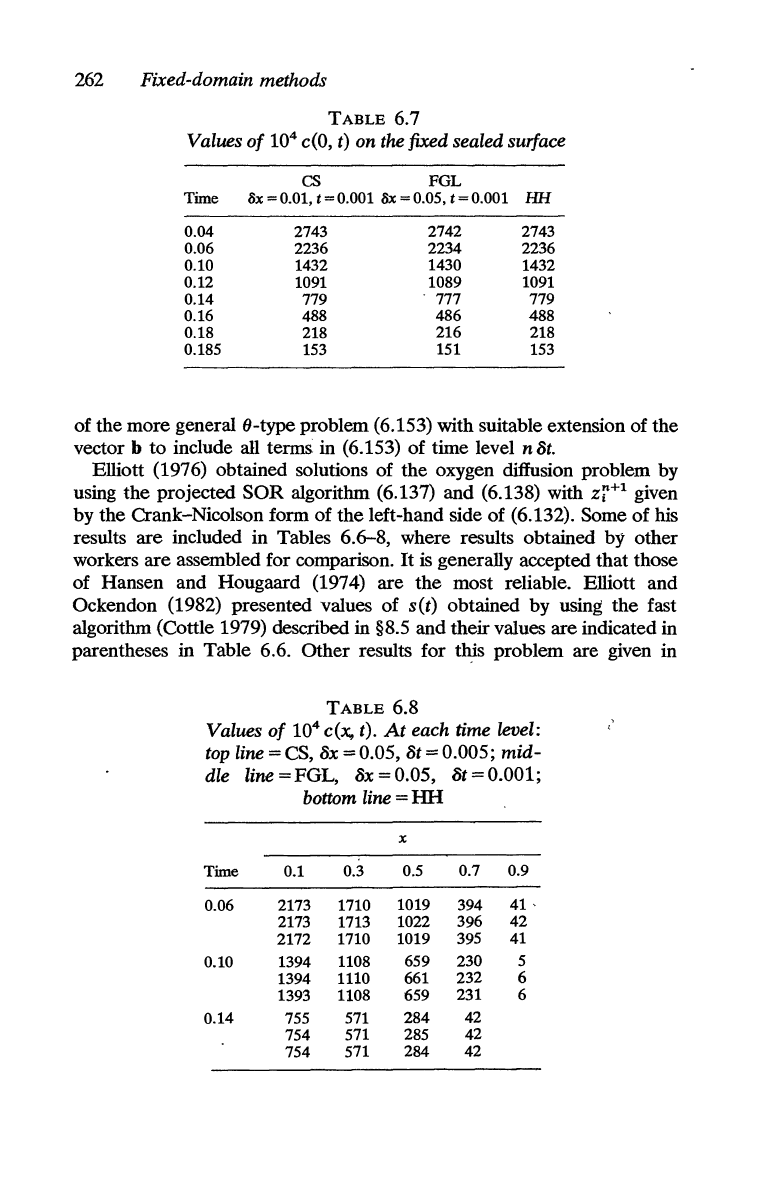
262
Fixed-domain methods
TABLE
6.7
Values
of
10
4
C(O,
t)
on the fixed sealed
sUrface
cs
FGL
Time
lix:=
0.01,
t:=
0.001
Iix = 0.05, t = 0.001
HH
0.04
2743
2742
2743
0.06 2236 2234
2236
0.10 1432
1430
1432
0.12
1091
1089
1091
0.14 779
. 777
779
0.16
488
486 488
0.18
218
216
218
0.185
153
151
153
of the
more
general O-type problem (6.153) with suitable extension of the
vector b
to
include all terms in (6.153) of time level n8t.
Elliott (1976) obtained solutions of the oxygen diffusion problem by
using
the
projected
SOR
algorithm (6.137) and (6.138) with zr+l given
by
the
Crank-Nicolson form of
the
left-hand side of (6.132). Some of his
results are included in Tables 6.6-8, where results obtained by other
workers
are
assembled for comparison.
It
is generally accepted that those
of Hansen and Hougaard (1974) are
the
most reliable. Elliott and
Ockendon (1982) presented values of
s(t) obtained by using
the
fast
algorithm (Cottle 1979) described in §8.5 and their values are indicated in
parentheses in Table 6.6.
Other
results for this problem are given in
TABLE
6.8
Values
of
10
4
c(x, t).
At
each time level:
,
top
line
=CS,
8x
=0.05,
8t=0.005; mid-
dle line=FGL,
8x=0.05,
8t=0.001;
bottom
line
=
HH
x
Time
0.1 0.3
0.5
0.7
0.9
0.06
2173
1710
1019
394
41·
2173
1713
1022 396
42
2172
1710
1019
395
41
0.10 1394
1108
659
230
5
1394
1110
661
232 6
1393
1108
659
231
6
0.14
755
571
284
42
754
571
285
42
754
571
284
42
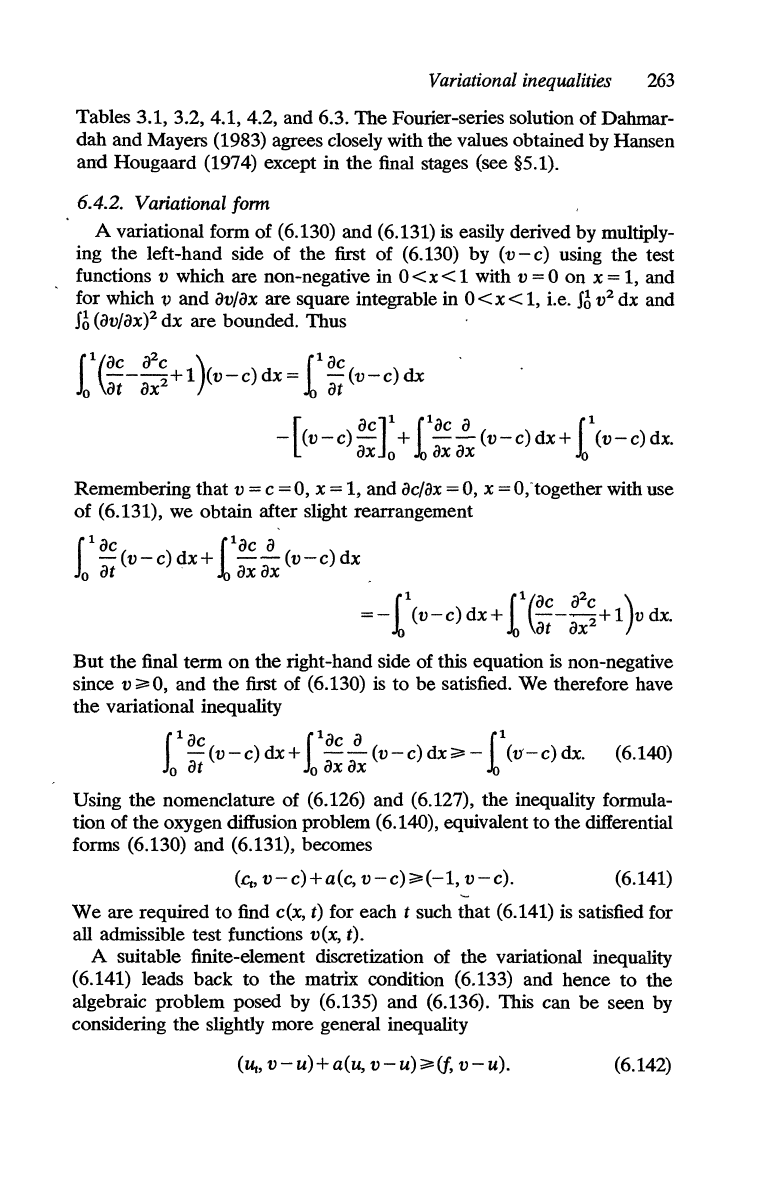
Variational inequalities
263
Tables 3.1, 3.2, 4.1, 4.2, and 6.3.
The
Fourier-series solution of Dahmar-
dab
and Mayers (1983) agrees closely with the values obtained by Hansen
and Hougaard (1974) except in
the
final stages (see §5.1).
6.4.2. Variational fonn
A variational fonn of (6.130) and (6.131) is easily derived by mUltiply-
ing the left-hand side of the first of (6.130) by
(v-c)
using
the
test
functions
v which are non-negative in 0
<x
< 1 with v = 0 on x =
1,
and
for which
v and av/ax are square integrable in 0 < x <
1,
i.e.
J~
v
2
dx and
J~
(av/ax)2
dx are bounded. Thus
1
1(ac a
2
c)
11
ac
---+1
(v-c)dx=
-(v-c)dx
o
at
ax
2
at
-[(v-c)
ac]l
+1
1
ac
~
(v-c)
dx+
I\v-c)
dx.
ax
0
ax
ax
\)
Remembering that v
=c=O,
x = 1, and
ac/ax
=0,
x = o ,'together with use
of (6.131), we obtain after slight rearrangement
1
1 ac 11ac a
-(v-c)dx+
--(v-c)dx
o at .
ax ax
=-1\v-C)dx+1
1
(ac - a
2
c
+l)V
dx.
at
ax
2
But
the
final
tenn
on
the right-hand side of this equation
is
non-negative
since
v;;;;o
0, and
the
first of (6.130)
is
to
be
satisfied. We therefore have
the
variational inequality
eac(v_c)dx+
e
ac
~(V-C)dx;;;;o-1\ti-C)dx.
(6.140)
J
o
at
J
o
ax
ax
Using
the
nomenclature of (6.126) and (6.127),
the
inequality fonnula-
tion of the oxygen diffusion problem (6.140), equivalent
to
the differential
forms (6.130) and (6.131), becomes
(ev
v-c)+a(c,
v-c);;;;o(-l,
v-c).
(6.141)
We
are required
to
find c(x, t) for each t such that (6.141) is satisfied for
all admissible test functions
vex,
t).
A suitable finite-element discretization of
the
variational inequality
(6.141) leads back to the matrix condition (6.133) and hence
to
the
algebraic problem posed by (6.135) and (6.136). This can
be
seen by
considering the slightly more general inequality
(Ut,
v-u)+a(u,
v-u);;;;o(f,
v-u).
(6.142)
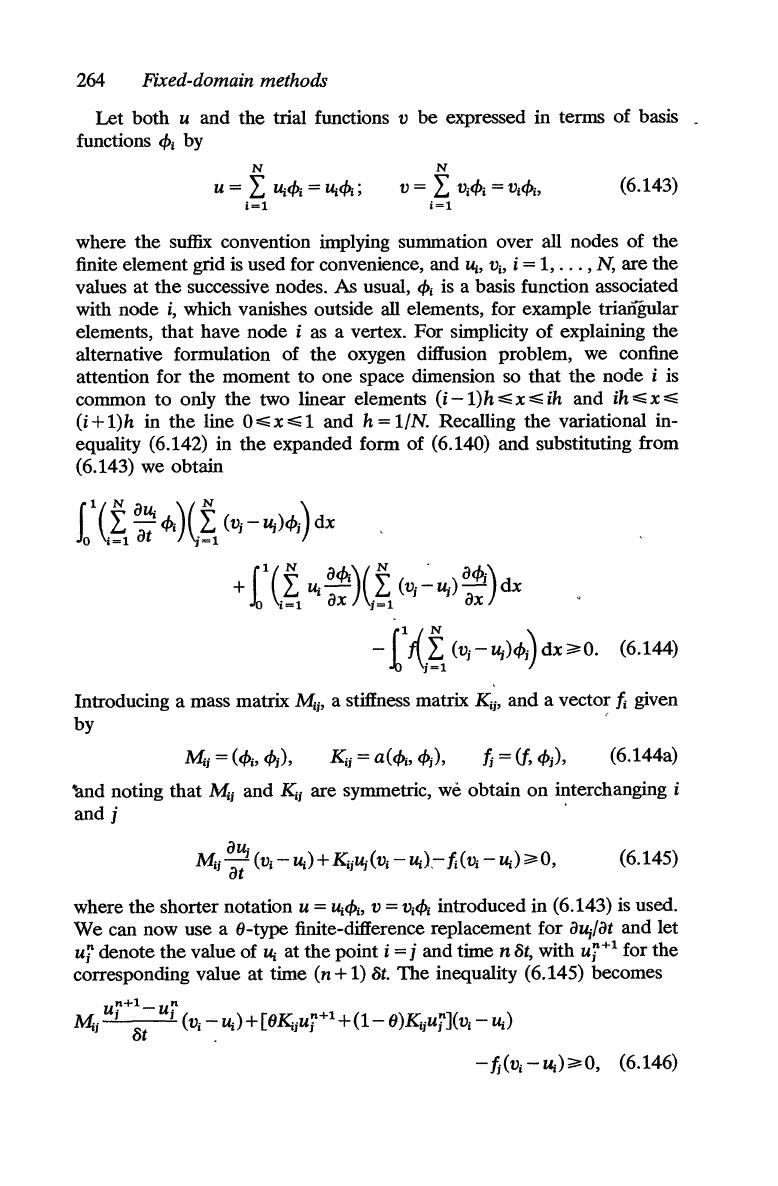
264 Fixed-domain methods
Let
both U and the trial functions v be expressed in terms of basis
functions
cf>i
by
N
U = L
Ujcf>i
=
Ujc/>i;
i=1
N
V = L
Vicf>i
=
Vicf>b
i=1
(6.143)
where the suffix convention implying sununation over
all nodes of the
finite element grid
is
used for convenience, and Uj, Vb i = 1,
...
,N,
are the
values at
the
successive nodes.
As
usual,
cf>i
is a basis function associated
with node
i,
which vanishes outside all elements, for example triangular
elements, that have node
i
as
a vertex. For simplicity of explaining the
alternative fonnulation of
the
oxygen diffusion problem, we confine
attention for
the
moment
to
one space dimension so that
the
node i is
conunon
to
only
the
two linear elements
(i-1)h~x~ih
and
ih~x~
(i
+
l)h
in
the
line 0
~
x
~
1 and h =
lIN.
Recalling
the
variational in-
equality (6.142) in
the
expanded
fonn
of (6.140)
and
substituting from
(6.143) we obtain
+ L
Uj-"
L
(Vj_Uj)_i
dx
i
1(N
ac/>i)(
N .
acf»
'=1
aX
i=1
aX
Introducing a mass matrix M;j, a stiffness matrix Kij' and a vector
{;
given
by "
(6. 144a)
"and
noting that M;j and
K;j
are synunetric, we obtain on interchanging i
andj
"
(6.145)
where
the
shorter notation U =
Ujc/>i,
v =
Vic/>i
introduced in (6.143)
is
used.
We
can now use a O-type finite-difference replacement for
aUjlat
and let
uj
denote
the
value of
Uj
at
the
point i = j and time n
8t,
with uj+1 for
the
corresponding value
at
time (n +
1)
8t.
The ineqUality (6.145) becomes
n+l
n
M;j
Uj
8;
Uj
(Vi
-
Uj)+[OK;juj+l+(l-
O)Kijuj](Vi -
Uj)
-fj(Vi
-Uj)~O,
(6.146)
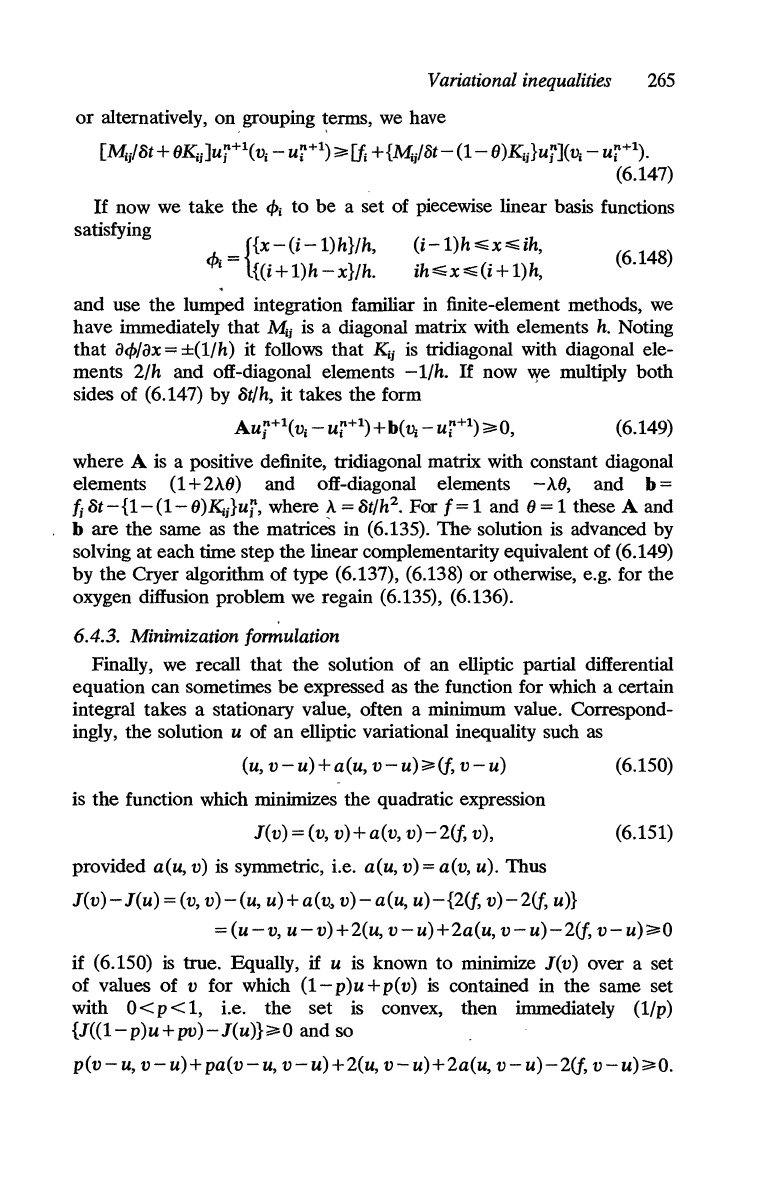
Variational inequalities
265
or
alternatively, on grouping
~erms,
we have
[Mi/St+
eKij]uj+1(Vi
-
ur+l);;;;.[J;
+{Mi/8t-(1-8)K
ii
}uj](vi - ur+
1
).
(6.147)
If
now we take the
cPi
to
be
a set of piecewise linear basis functions
satisfying
_
{{x
-
(i
-l)h}/h,
cPi
- {(i +
l)h
- xl/h.
(i
-l)h:s;x:s;
ih,
ih:s;
x:s;
(i
+ l)h,
(6.148)
and
use the lumped integration familiar in finite-element methods, we
have immediately that
Mii
is
a diagonal matrix with elements
h.
Noting
that
acP/ax=±(l/h) it follows that
Kij
is
tridiagonal with diagonal ele-
ments 2/h and off-diagonal elements -1Ih.
If
now
V(e
multiply both
sides of (6.147) by
at/h,
it takes
the
form
(6.149)
where A
is
a positive definite, tridiagonal matrix with constant diagonal
elements (1
+
2Ae)
and off-diagonal elements -
Ae,
and b =
~
St
-{1-
(1-
e)~i}uj,
where A = St/h
2
•
For f = 1 and e = 1 these A and
b
are
the
same
as
the matriceS in (6.135).
The
solution
is
advanced by
solving
at
each time step the linear complementarity equivalent of (6.149)
by
the
Cryer algorithm of type (6.137), (6.138)
or
otherwise, e.g. for the
oxygen diffusion problem we regain (6.135), (6.136).
6.4.3. Minimization formulation
Finally, we recall that
the
solution of an elliptic partial differential
equation can sometimes
be
expressed as the function for which a certain
integral takes a stationary value, often a minimum value. Correspond-
ingly,
the
solution u of an elliptic variational inequality such as
(u,
v-u)+a(u,
v-u);;;;.(f,
v-u)
is
the
function which minimizes the quadratic expression
J(v) = (v, v) + a(v,
v)-2(f,
v),
provided a(u, v) is symmetric, i.e. a(u, v) = a(v, u). Thus
J(v)-J(u)
= (v, v)
-(u,
u)
+a(v~
v) - a(u,
u)-{2(f,
v)-2{f,
u)}
(6.150)
(6.151)
=
(u-v,
u-v)+2(u,
v-u)+2a(u,
v-u)-2(f,
v-u);;;;.O
if (6.150) is true. Equally,
if
u is known
to
minimize J(v) over a set
of values
of
v for which
(l-p)u+p(v)
is contained in the same set
with
O<p<l,
i.e.
the
set is convex, then immediately
(l/p)
{J«l-p)u+pv)-J(u)};;;;.O
and so
p(v
-u,
v-u)+pa(v-u,
v-u)+2(u,
v-u)+2a(u,
v-
u)-2(f,
v-u);;;;.O.
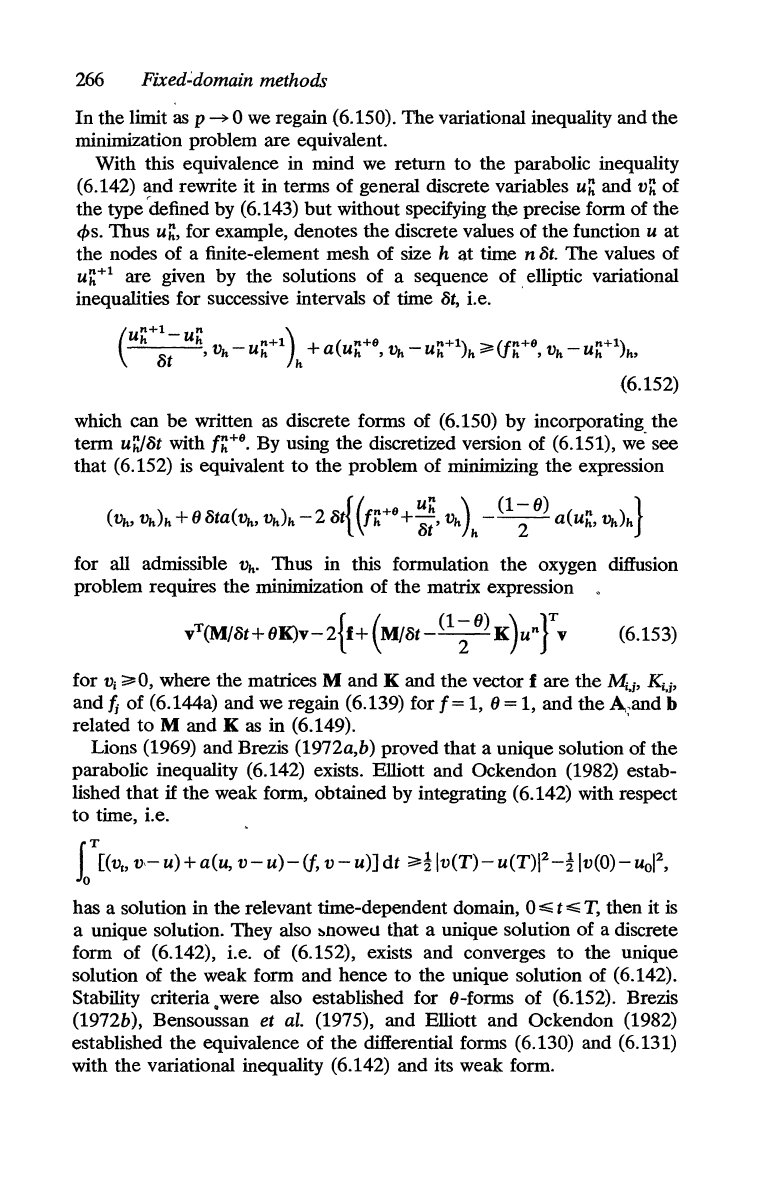
266
Fixed~domain
methods
In
the limit
as
p
~
0 we regain (6.150). The variational inequality and
the
minimization problem are equivalent.
With this equivalence in mind we return
to
the parabolic inequality
(6.142) and rewrite it in terms of general discrete variables
u;:
and
v;:
of
the type
cdefined
by (6.143)
but
without specifying
the
precise form of the
</Js.
Thus
u;:,
for example, denotes the discrete values of
the
function u at
the nodes of a finite-element mesh of size h
at
time n
St.
The
values of
U;:+l are given by the solutions of a sequence
of.
elliptic variational
inequalities for successive intervals of time
8t,
i.e.
(
U;:+l_
U
;:
""
_u
n
+
1
)
+a(u
n
+
6
n
_u
n
+
1
) >-(jn+6 V
_u
n
+
1
)
8t '
~"
h h
h,
~n
h h
..-
h
,h
h
h,
(6.152)
which can
be
written
as
discrete forms of (6.150) by incorporating
the
term uh/8t with
t;:+fI.
By using
the
discretized version of (6.151), we'see
that (6.152) is equivalent
to
the
problem of minimizing
the
expression
for
all admissible
Vh'
Thus in this formulation
the
oxygen diffusion
problem requires
the
minimization of
the
matrix expression
(6.153)
for
Vi
;;3:0,
where the matrices M and K and
the
vector f are
the
M;.i>
K;.i'
and t of (6.144a) and we regain (6.139) for t =
1,
0 = 1, and
the
A.and
b
related
to
M and K
as
in (6.149). '
Lions (1969) and Brezis
(1972a,b) proved that a unique solution of
the
parabolic inequality (6.142) exists. Elliott and Ockendon (1982) estab-
lished that
if
the
weak form, obtained by integrating (6.142) with respect
to
time, i.e.
I
T
[(V"
v,-
u)
+a(u,
v-
u)-(j,
v -
u)]
dt
;;;.:t
Iv(T)-
u(T)12_t
Iv(O)-
Uof,
has a solution in the relevant time-dependent domain, 0
~
t
~
T,
then it
is
a unique solution. They also :.nowell that a unique solution
of
a discrete
form of (6.142), i.e. of (6.152), exists and converges
to
the unique
solution of
the
weak form and hence
to
the
unique solution of (6.142).
Stability criteria .were also established for O-forms of (6.152). Brezis
(1972b), Bensoussan et al. (1975), and Elliott and Ockendon (1982)
established
the
equivalence of
the
differential forms (6.130) and (6.131)
with
the
variational inequality (6.142) and its weak form.
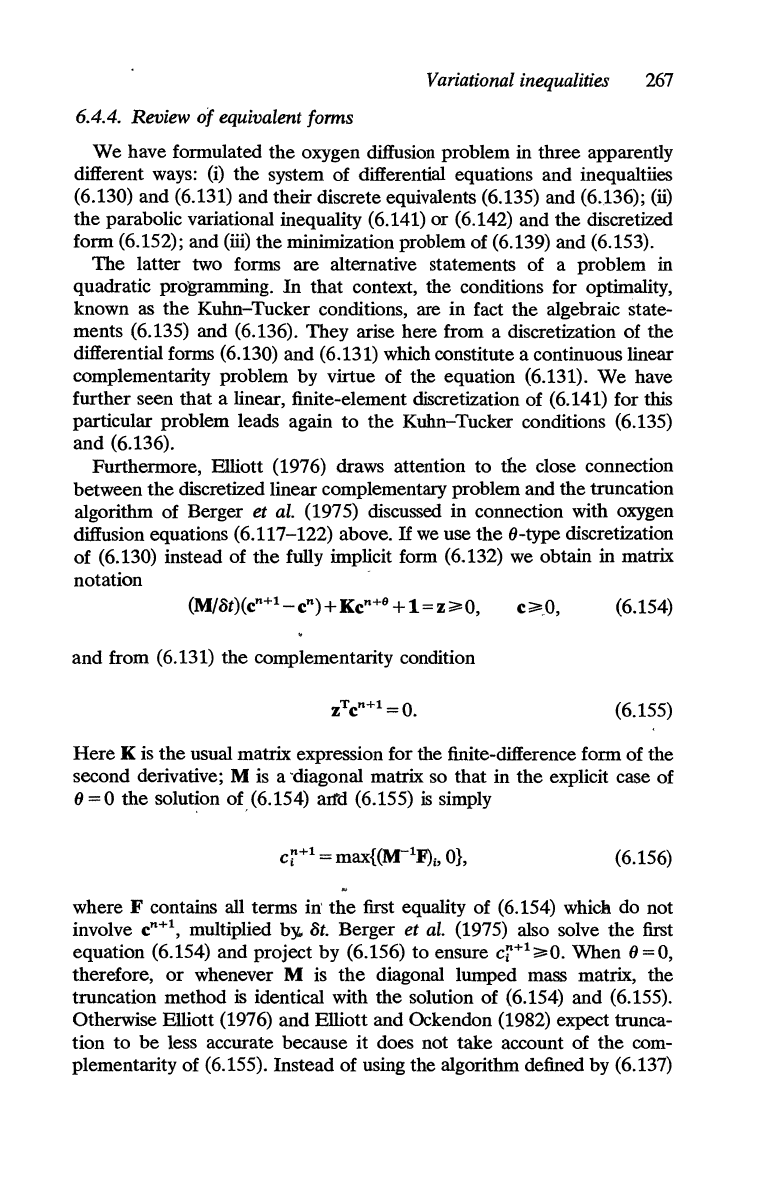
Variational inequalities
267
6.4.4. Review
of
equivalent forms
We
have formulated the oxygen diffusion problem in three apparently
different ways:
(i)
the system of differential equations and inequaltiies
(6.130) and (6.131) and their discrete equivalents (6.135) and (6.136);
(ii)
the parabolic variational inequality (6.141) or (6.142) and the discretized
form (6.152); and
(iii)
the minimization problem of (6.139) and (6.153).
The
latter two forms are alternative statements of a problem in
quadratic programming.
In
that context, the conditions for optimality,
known
as
the Kuhn-Tucker conditions, are in fact
the
algebraic state-
ments (6.135) and (6.136). They arise here from a discretization of the
differential forms (6.130) and (6.131) which constitute a continuous linear
complementarity problem by virtue of the equation (6.131).
We
have
further seen that a linear, finite-element discretization of (6.141) for this
particular problem leads again
to
the
Kuhn-Tucker conditions (6.135)
and (6.136).
Furthermore, Elliott (1976) draws attention to the close connection
between
the
discretized linear complementary problem and the truncation
algorithm of Berger
et
ai.
(1975) discussed in connection with oxygen
diffusion equations (6.117-122) above.
If
we
use
the
8-type discretization
of (6.130) instead of
the
fully implicit form (6.132) we obtain in matrix
notation
(M/~t)(en+l-
en)
+
Ke
n
+
8
+ 1 = z
;;;;'0,
(6.154)
and from (6.131)
the
complementarity condition
(6.155)
Here
K
is
the
usual matrix expression for the finite-difference form of the
second derivative; M
is
a 'diagonal matrix so that in
the
explicit case of
8=0
the
solution
of(6.154)
aIfd (6.155)
is
simply
(6.156)
where F contains
all terms
in'
the
first equality of (6.154) which do not
involve
en+t,
multiplied
by.
&.
Berger et
al.
(1975) also solve
the
first
equation (6.154) and project by (6.156)
to
ensure ci+
1
;;;;.0.
When
8=0,
therefore,
or
whenever M
is
the
diagonal lumped mass matrix, the
truncation method
is identical with the solution of (6.154) and (6.155).
Otherwise Elliott (1976)
and
Elliott and Ockendon (1982) expect trunca-
tion
to
be
less accurate because it does not take account of the com-
plementarityof (6.155). Instead of using the algorithm defined by (6.137)
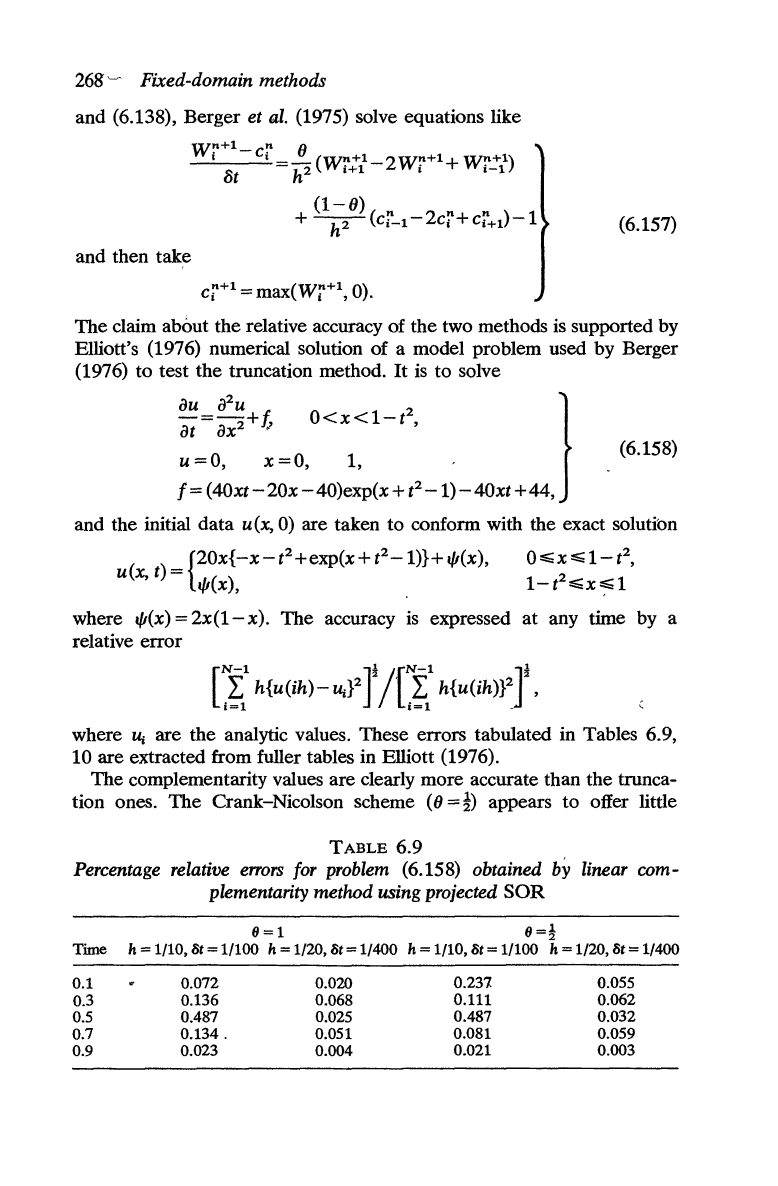
268~'
Fixed-domain methods
and (6.138), Berger et al. (1975) solve equations like
lit
o
(um+1
2wn+1+
um+1)
h
2
I'Y
.+1
- •
I'Y
.-1
(1-0)
n n n
+
~(Ci-1-2ci
+Ci+1)-1
(6.157)
and then take
The
claim about
the
relative accuracy of
the
two methods is supported by
Elliott's (1976) numerical solution
of
a model problem used by Berger
(1976)
to
test
the
truncation method.
It
is
to
solve
:;=::~+t
0<x<1-t
2
, }
u=O
x=O
1 '
f =
(~Oxt
-20x
~40)e~p(x
+ t
2
-1)-40xt
+44,
(6.158)
and the initial
data
u(x,O) are taken
to
conform with the exact solution
( )
_
{20x{-x-t
2
+exp(x+
t
2
-1)}+
t{I(x),
u
x,
t -
t{I(x),
0~X~1_t2,
1_t2~x~1
where
t{I(x)=2x(1-x).
The
accuracy
is
expressed
at
any time by a
relative
error
Ct:
h{u(ih)
-
u,}2
r
ICt1
1
h{U(ih)}2]! ,
where
U,
are
the
analytic values. These errors tabulated in Tables 6.9,
10 are extracted from fuller tables in Elliott (1976).
The
complementarity values are clearly more accurate than
the
trunca-
tion ones.
The
Crank-Nicolson scheme (0
=t)
appears
to
offer little
TABLE
6.9
Percentage relative
errors
for problem (6.158) obtained by linear com-
plementarity method using projected
SOR
6=1
6=!
Time h = 1/10, 8t = 1/100 h = 1/20,
8t
= 1/400 h = 1/10, 8t = 1/100 h = 1/20,
8t
= 1/400
0.1
0.3
0.5
0.7
0.9
0.072
0.136
0.487
0.134 .
0.023
0.020
0.068
0.025
0.051
0.004
0.231
0.111
0.487
0.081
0.021
0.055
0.062
0.032
0.059
0.003
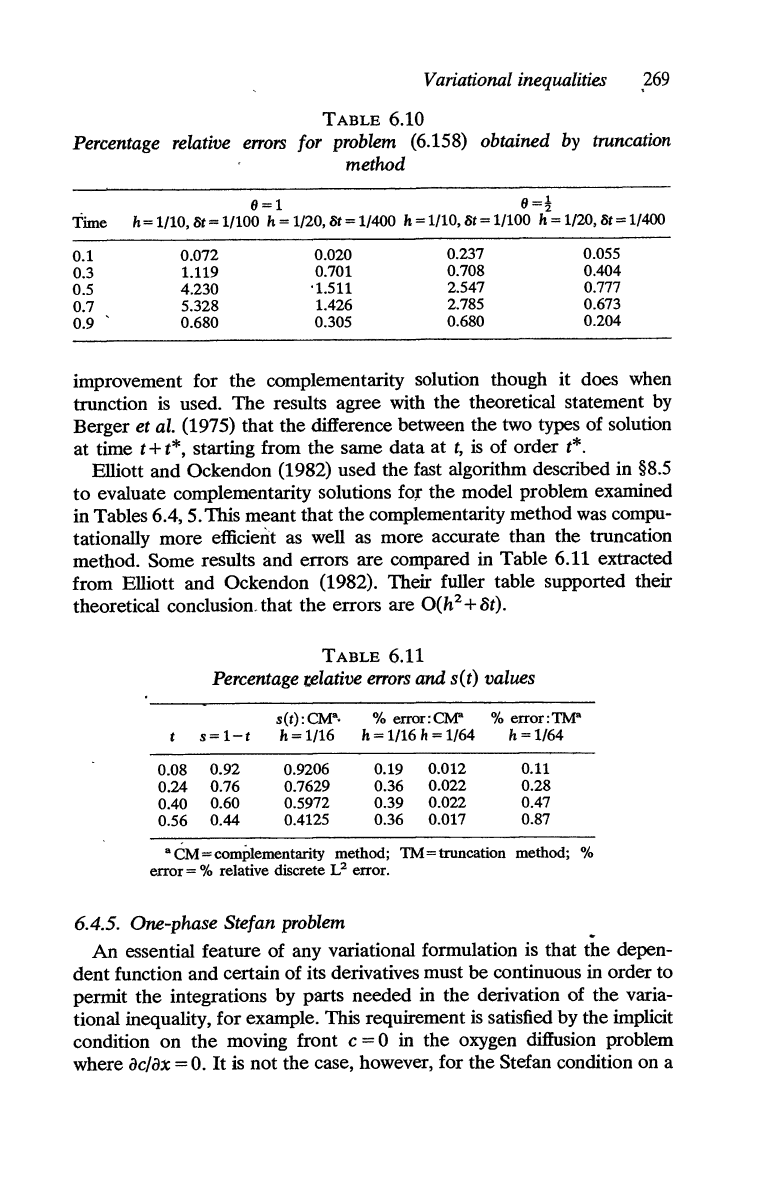
Variational inequalities
269
TABLE
6.10
Percentage relative
errors
for problem (6.158) obtained by truncation
method
Time
0.1
0.3
0.5
0.7
0.9
8=1
8=!
h = 1/10, 8t = 1/100 h = 1/20,
Sf
= 1/400 h = 1/10,
Sf
= 1/100 h = 1/20, 8t = 1/400
0.072
1.119
4.230
5.328
0.680
0.020
0.701
'1.511
1.426
0.305
0.237
0.708
2.547
2.785
0.680
0.055
0.404
0.777
0.673
0.204
improvement for
the
complementarity solution though it does when
trunction
is
used.
The
results agree with
the
theoretical statement by
Berger
et al. (1975) that
the
difference between
the
two types of solution
at time t
+ t*, starting from
the
same data
at
t,
is
of order
t*.
Elliott and Ockendon (1982) used
the
fast algorithm described in §8.5
to
evaluate complementarity solutions for
the
model problem examined
in Tables 6.4, 5. This meant that
the
complementarity method was compu-
tationally more efficient as well as more accurate than the truncation
method. Some results and errors are compared in Table 6.11 extracted
from Elliott and Ockendon (1982). Their fuller table supported their
theoretical conclusion. that
the
errors are
O(h
2
+8t).
TABLE
6.11
Percentage
r,elative
errors and s(t) values
s(t):eM".
% error:
eM"
%
error:TM"
s=l-t
h=1/16
h = 1/16 h = 1/64
h =1/64
0.08
0.92
0.9206
0.19
0.012
0.11
0.24
0.76
0.7629 0.36
0.022
0.28
0.40
0.60
0.5972 0.39 0.022
0.47
0.56
0.44 0.4125
0.36 0.017
0.87
aCM=comPIementarity method; TM=truncation method;
%
error = % relative discrete L2 error.
6.4.5. One-phase Stefan problem
An
essential feature of any variational formulation is that
the
depen-
dent
function and certain of its derivatives must
be
continuous in order to
permit
the
integrations by parts needed in
the
derivation of
the
varia-
tional inequality, for example. This requirement
is
satisfied
by
the implicit
condition on
the
moving front c = 0 in
the
oxygen diffusion problem
where
ac/ax
=
O.
It
is not
the
case, however, for
the
Stefan condition on a
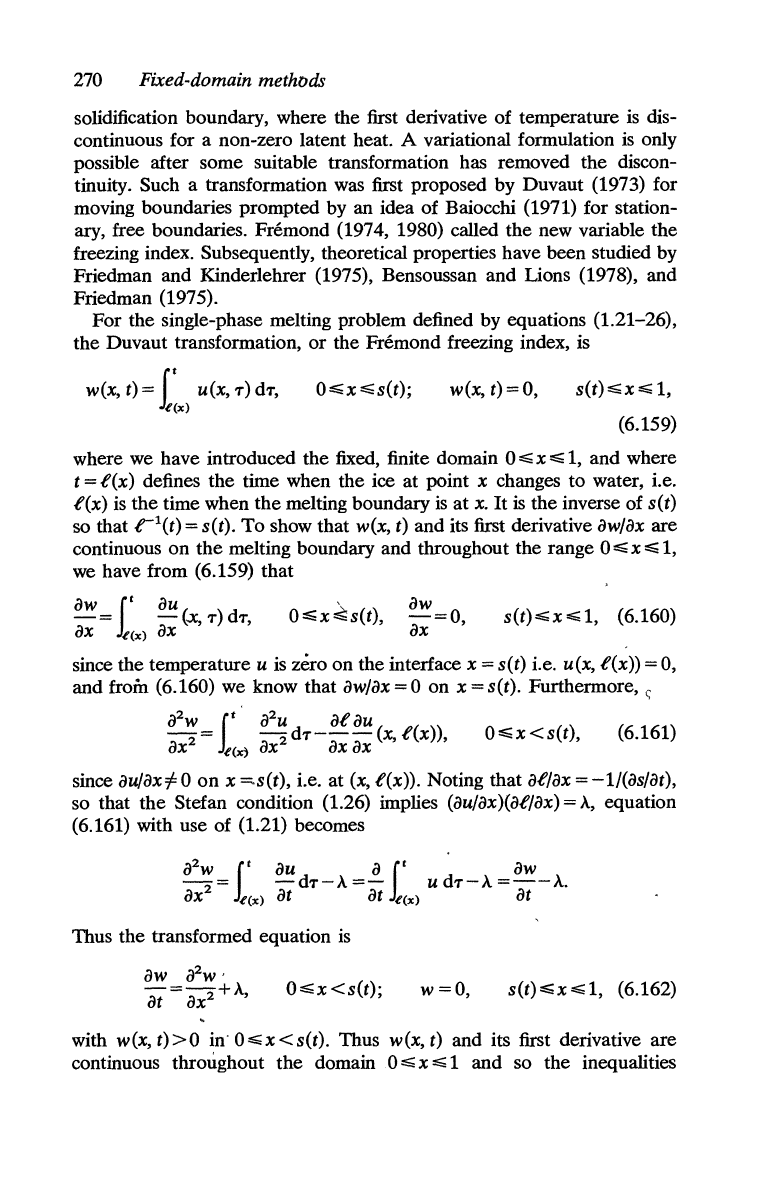
270
Fixed-domain methods
solidification boundary, where the first derivative of temperature
is
dis-
continuous for a non-zero latent heat. A variational formulation
is
only
possible after some suitable transformation has removed the discon-
tinuity. Such a transformation was first proposed by Duvaut
(1973) for
moving boundaries prompted by an idea of Baiocchi (1971) for station-
ary, free boundaries. Fremond
(1974, 1980) called
the
new variable
the
freezing index. Subsequently, theoretical properties have been studied by
Friedman and Kinderlehrer
(1975), Bensoussan and Lions (1978), and
Friedman
(1975).
For
the single-phase melting problem defined by equations (1.21-26),
the
Duvaut transformation,
or
the Fremond freezing index, is
w(x,
t)
=:
It
u(x,
-r)
d-r,
~(x)
O:s;;x
:S;;s(t);
w(x,
t)=O,
(6.159)
where we have introduced the fixed, finite domain
O:s;;
x
:s;;
1,
and where
t =
f(x)
defines
the
time when the ice at point x changes
to
water, i.e.
f(x)
is
the
time when
the
melting boundary
is
at
x.
It
is
the
inverse of
s(t)
so that
rl(t)
= s(t).
To
show that
w(x,
t)
and its first derivative ow/ax are
continuous
on
the
melting boundary and throughout the range
O:s;;
x:s;;
1,
we have from
(6.159) that
oW
11
au
-=
-(.x,-r)d-r,
ax
~(x)
ax
aw=O
ax
'
s(t):s;;x:s;;
1, (6.160)
since the temperature u
is
zero on the interface x =
s(t)
i.e. u(x,
f(x»
= 0,
and from
(6.160) we know that ow/ax = 0 on x = s(t). Furthermore,
<:
a
2
w
It
a
2
u
of
au
-2
=
-2
d-r---
(x,
f(x»,
ax
~(x)
ax ax
ax
O:S;;x<s(t),
(6.161)
since
au/ax=/=
°
on
x
=.s(t),
i.e. at (x,
f(x».
Noting that
of/ax
=
-lI(as/at),
so that
the
Stefan condition (1.26) implies (au/ax){af/ax) =
A,
equation
(6.161) with use of (1.21) becomes
a
2
w 1 t
au
a 1 I
oW
-2=
-d-r-A=-
ud-r-A=--A.
ax
(x)
at at
~(x)
at
Thus the transformed equation
is
oW
a
2
w'
at=
ax
2
+A,
O:S;;x<s(t);
w=O,
with
w(x,
t»O
in'
O:s;;x<s(t).
Thus
w(x,
t)
and its first derivative are
continuous throughout
the
domain
O:s;;
x
:s;;
1 and so
the
inequalities
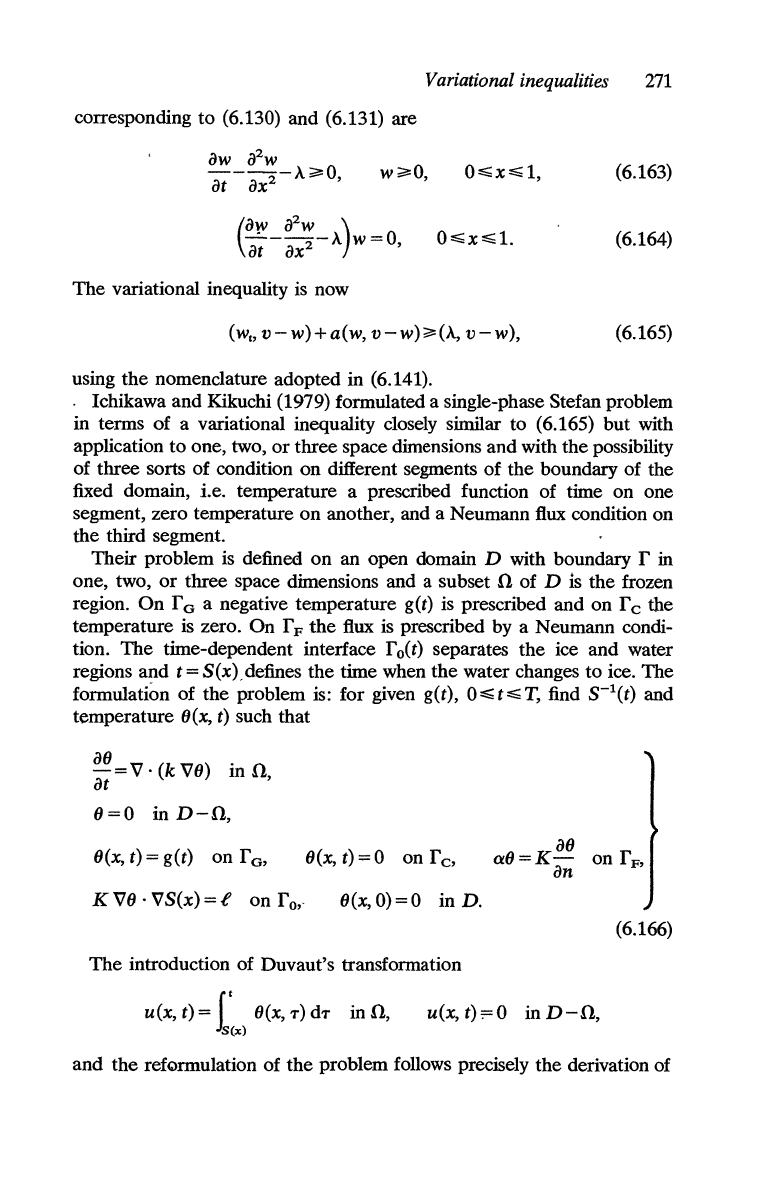
Variational inequalities
271
corresponding
to
(6.130) and (6.131) are
w;;;.O,
(
a
w
_
a
2
W
-A)W
=0
at
ax
2
'
The
variational inequality
is
now
O,,;;;x,,;;;l,
(W"
v-w)+a(w,
V-W);;;'(A,
V-W),
using
the
nomenclature adopted in (6.141).
(6.163)
(6.164)
(6.165)
. Ichikawa and Kikuchi (1979) formulated a single-phase Stefan problem
in terms of a variational inequality closely similar to
(6.165) but with
application
to
one, two,
or
three space dimensions and with
the
possibility
of three sorts of condition on different segments of the boundary of the
fixed domain, i.e. temperature a prescribed function of time on one
segment, zero temperature on another, and a Neumann
flux condition on
the third segment.
Their problem is defined on an open domain
D with boundary f in
one, two,
or
three space dimensions and a subset a of D is the frozen
region.
On
f G a negative temperature
get)
is prescribed and on f c the
temperature is zero.
On
f F
the
flux is prescribed by a Neumann condi-
tion.
The
time-dependent interface
fo(t)
separates
the
ice and water
regions and
t=S(x).defines
the
time when
the
water changes to ice.
The
formulation of
the
problem is: for given
get),
O,,;;;t,,;;;T,
find
S-l(t)
and
temperature
6(x, t) such that
a6
= V .
(k
V6) in a
at
'
6=0
in
D-a,
6(x, t) =
get)
on f
G,
KV6·
VS(x)=f
on
fo,
6 (x,
0)
= 0 in D.
The
introduction of Duvaut's transformation
a6
016
= K - on f
F,
an
(6.166)
U(x,
t) = r 6(x,
T)
dT
in
a,
S(",)
u(x, t);::O in
D-a,
and
the
reformulation of
the
problem follows precisely
the
derivation of
